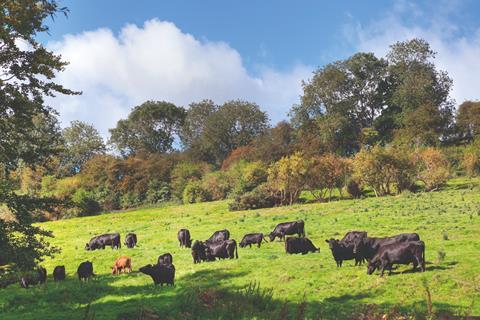Recent cattle population data from the British Cattle Movement Service (BCMS) indicates a significant increase in prime cattle numbers on Scottish farms compared to 2023.

This is despite a reported decrease in Scotland’s overall beef herd over the past year.
According to the latest market commentary by Quality Meat Scotland (QMS), in April 2024 there was a marked 4.4% increase in the pool of males and beef-sired females aged 12 to 30 months compared to the previous year.
Iain Macdonald, market intelligence manager at QMS, commented: “Despite the continuing decline in Scotland’s beef herd, the BCMS data shows that the small year-on-year increases in prime cattle on Scottish farms in the second half of 2023 have become more significant in 2024. This is likely to have been even stronger after accounting for age at death and is likely to have contributed to the downwards pressure on prime cattle prices observed in the spring.

“However, a seasonal dip in availability for slaughter has resulted in a slight price rebound since mid-June, with R4L steers reaching 489.8p/kg at Scottish abattoirs in the second week of July - 1.6% above the early-June low, yet still 3.9% below the year-to-date peak in February.”
QMS found that a decline in the outflow of store cattle to England and Wales from its peak had driven the year-on-year increase in prime cattle supply on Scottish farms. The legacy of an increased spring calf crop in 2022 also contributed to the increase in prime cattle supply.
Macdonald commented: “It’s worth noting that the elevated outflow of store cattle to England continues to squeeze the prime cattle kill at Scottish abattoirs. While slaughter numbers showed some increase from the lows of 2023 in the second quarter of this year, they still remained well below the five-year average.”
QMS predicts “strong competition” between Scotland and Great Britain
BCMS data from April suggested that prime cattle numbers are expected to remain higher than a year earlier on Scottish farms in the second half of 2024, although the rate of increase is reportedly likely to soften as the slaughter pool shifts towards younger age groups. This aged 12-18 months in April were up by a smaller 2% on the year, found QMS, while a reduction at 6-12 months in April may begin to impact availability in the final quarter of 2024, with peak effects expected by spring 2025 due to a typical age at death of around 21 months.
Macdonald noted: “South of the border, the picture is slightly different. There was a smaller year-on-year increase in slaughter availability in the first half compared to Scotland, and this trend is expected to continue into the third quarter before potentially tightening compared to 2023 in the run up to Christmas.
“This reflects earlier declines in calf registrations in England and Wales compared to Scotland during the 2022 herd contraction. Unlike Scotland, there was a small decline in the 12-18-month age group in April compared to a year earlier, while the rise at 18-24 months was approximately one third of the 6% increase seen in Scotland.”
“A seasonal dip in availability for slaughter has resulted in a slight price rebound since mid-June.”
QMS saw “steep reductions” of over 4% in the 6-12 month age group on both sides of the border, stating that it pointed to a very tight supply of shorter keep store cattle at autumn sales.
It predicted that this would result in “strong competition” for Scottish-born stores from finishers across Great Britain, and for longer keep stores, QMS said supply would remain tight with year-on-year reductions at under six months in April closer to 2%.
Macdonald said: “Concerningly, BCMS population data signals a renewed acceleration in the year-on-year decline of the beef breeding herd, with beef-sired females aged over 30 months on Scottish farms down 2.4% from April 2023. Meanwhile, the decline in England and Wales continued to outpace Scotland, showing a year-on-year reduction of 3.2%, indicating ongoing competition for Scotland’s suckler-bred store cattle.
“Looking back over the past six years, the decline in beef-sired females in England and Wales has been significantly steeper than in Scotland, at 14.2% compared to 10.4% for those aged over 30 months. Consequently, it’s crucial to support Scottish finishers to enhance competitiveness and maximise the number of Scotch-eligible cattle remaining in Scotland.”
Prime cattle availability to experience “continued pressure”
A further decline in Scotland’s beef herd this year means that a reduced 2024 calf crop follows a 2.7% fall in calf registrations in 2023, found QMS, pointing to “further tightening” of store cattle availability in 2025 and “continued pressure” on prime cattle availability in 2026.
Macdonald concluded: “In addition to reduced economic activity from farming and processing, a declining beef herd will impact the output, GVA, and jobs generated by their supply sectors, potentially leading to wider social impacts.
“To counteract these trends, modelling indicates that taking action in Scotland to stabilise the beef herd, boost productivity, and reduce the outflow of store cattle could shift the economic narrative from contraction to growth by 2030.
“Meanwhile, given similar downward trends in beef production south of the border, there is potential for significant impact on UK food security. With beef demand holding steady amid the cost-of-living crisis and the UK population projected to grow, a widening gap between domestic production and total beef consumption by 2030 could require higher imports, sourced from regions with varying standards of production, which are also facing increased drought stress due to climate change.”















